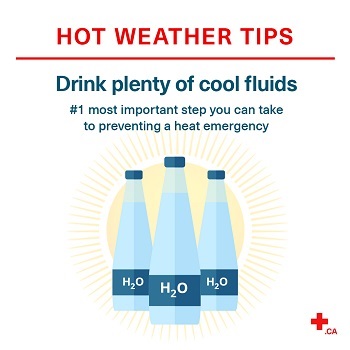Summer is in full swing in many parts of Canada and folks are enjoying more time outside whether at the lake, lounging poolside or tending to that lawn that needs mowing.
 While we may be tempted to simply throw on our sandals and rush outside to soak up the sun, there are some important heat-related safety tips to keep in mind.
While we may be tempted to simply throw on our sandals and rush outside to soak up the sun, there are some important heat-related safety tips to keep in mind.Heat-related emergencies such as heat cramps, heat exhaustion, or heat stroke, can happen to anyone who stays in the summer heat and sun for too long.
Preventing a heat-related emergency
Prevention really is the best medicine! The best way to deal with a heat-related emergency is to avoid one altogether.
- Drink plenty of cool fluids before and during your time outside
- Apply sunscreen with SPF 15 or higher as a sunburn will reduce your body’s ability to cool itself
- Stock your backpack with the essentials like sunscreen, sunglasses and plenty of water to keep you hydrated
- Wear a hat - a perfect excuse to get yourself a new accessory!
- Avoid being outside during the hottest part of the day
- Check your local humidex as the humidity will make a hot day feel even hotter
- Take lots of hydration breaks and cool off in the shade - don’t forget to reapply sunscreen while you’re at it!
- Adjust your activity and avoid playing or working for too long in the heat
Recognizing a heat-related emergency
When spending time in the sun and heat watch out for these symptoms in yourself and those around you.
Heat Exhaustion
- Moist, warm skin
- Headache
- Nausea, vomiting, fainting
- Anxiety, dizziness
- Weakness, exhaustion
- Normal breathing
How to help someone experiencing heat exhaustion:
- Move the person to a cooler location like a shaded spot under a tree or a building with air conditioning
- Have the person loosen any tight clothing including backpacks, purses and belts
- Do not dry skin
- Fan the person
- Put cool water on the person’s skin (torso)
- If they are alert, give the person cool water to drink in sips
Heat Stroke
- Dry, hot skin
- Severe headache, seizures, coma
- Altered behaviour: irritable, aggressive, bizarre
- Rapid, shallow breathing
How to help someone experiencing heat stroke:
- Call EMS/9-1-1
- Move the person away from the heat to a cooler area
- Loosen tight clothing
- Do not dry skin
- Use aggressive cooling (in order of preference). Immerse body in cool water, immerse forearms in cool water, pour water on torso, fan skin
- If person is alert, provide sips of a cool drink
With more heatwaves on the horizon it’s important for you and your loved ones to know how to prevent, recognize and treat a heat-related emergency.
Learn more on what to do before, during and after a heatwave.
Download the free CanadianRed Cross First Aid App so that you always have first aid advice at your fingertips.
Related stories:

